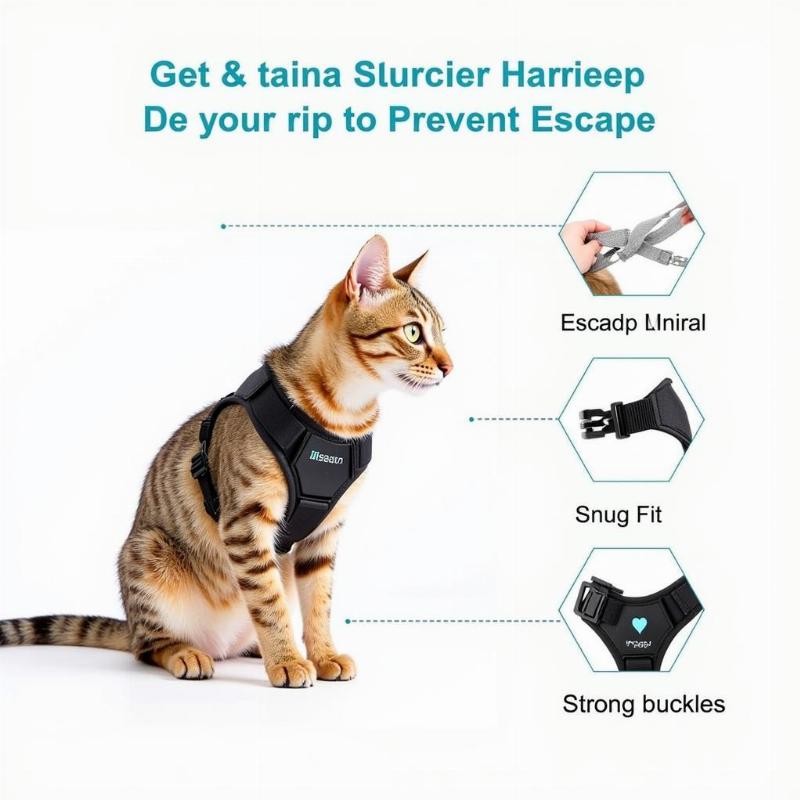Choosing the right harness for your furry friend is crucial for their safety and comfort. While it may seem simple, there are key differences between cat harnesses and dog harnesses that every pet owner should know. Using the wrong type of harness can not only be uncomfortable for your pet, but also potentially dangerous. This article will explore the critical distinctions between cat harnesses and dog harnesses, helping you make the best choice for your beloved companion.
Why the Difference Matters: Escape Artists vs. Loyal Companions
Cats and dogs, while both beloved pets, have vastly different physiques and temperaments. Cats, known for their flexibility and escape artistry, require harnesses specifically designed to prevent them from slipping out. A dog harness, typically designed for strength and control, may not offer the same level of security for a feline. On the other hand, a cat harness might be too restrictive or flimsy for a dog, especially larger breeds.
 Cat harness escape proof
Cat harness escape proof
Design Discrepancies: Form Follows Function
The most obvious difference lies in the design. Cat harnesses are typically H-shaped or vest-style, offering a snug fit that distributes pressure evenly across the body. This design minimizes the risk of choking and allows for greater freedom of movement while preventing escapes. They also often feature escape-proof buckles and adjustable straps for a customized fit. Dog harnesses, on the other hand, come in a wider variety of styles, including step-in, back-clip, front-clip, and no-pull harnesses. These designs prioritize control and comfort for walks, training, and other activities.
Sizing and Fit: A Tailored Approach
Size and fit are paramount. A properly fitted harness should be snug but not restrictive, allowing two fingers to fit comfortably between the harness and your pet’s body. Because of cats’ slender frames and flexibility, cat harnesses are designed with smaller buckles and adjustable straps for a secure fit. Dog harnesses, catering to a broader range of sizes and breeds, come in various sizes and adjustable points. Measuring your pet accurately is essential to ensure a comfortable and safe fit.
Material Matters: Durability and Comfort
The materials used in cat and dog harnesses also differ. Cat harnesses often utilize lightweight, breathable materials like nylon or mesh to avoid overheating. Durability is still key, as cats can be surprisingly strong when they want to be. Dog harnesses, designed for more robust activities, often incorporate stronger materials like nylon webbing, leather, or neoprene. The material should be durable enough to withstand pulling and comfortable enough for extended wear.
When in Doubt, Consult the Experts
Choosing between a cat harness and a dog harness is a matter of safety and comfort for your pet. If you’re unsure which type is best, consult with your veterinarian or a professional pet groomer. They can offer personalized advice based on your pet’s breed, size, and temperament.
Conclusion: The Right Harness for the Right Pet
Choosing the right harness, whether for a cat or a dog, boils down to understanding the unique needs of each animal. By considering their physical characteristics, temperament, and intended activities, you can ensure a safe, comfortable, and enjoyable experience for both you and your furry friend. Remember to prioritize a proper fit and choose durable, appropriate materials for long-lasting use.
FAQ
- Can I use a dog harness on my cat? Generally, it’s not recommended. Dog harnesses are not designed for a cat’s flexibility and escape artistry, and could potentially be unsafe.
- What type of harness is best for a cat who likes to escape? An H-shaped or vest-style harness with escape-proof buckles is the best option for escape artist cats.
- How do I measure my dog for a harness? Measure your dog’s girth around the chest, just behind the front legs, and consult a sizing chart for the specific harness you’re considering.
- What is the best material for a dog harness? Durable materials like nylon webbing, leather, or neoprene are good choices, depending on your dog’s activity level and the climate.
- How can I tell if a harness fits my pet correctly? You should be able to fit two fingers comfortably between the harness and your pet’s body.
Related Articles on Beautdogs.us
Beautdogs.us is your premier online destination for all things dog-related in the US. We offer expert advice on dog breeds, care, and lifestyle, providing a trusted source of information for both novice and experienced dog owners. Our expertise extends to product recommendations, ensuring you have access to the best products for your canine companion. For more information, contact us at [email protected] or call us at +1 501-555-7529. Visit Beautdogs.us today!